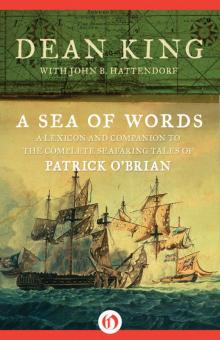Skeletons on the Zahara: A True Story of Survival Read online
Page 8
“Stow the gear,” ordered Riley. Wading through the surf from the brig to the longboat under the mates’ direction, the men loaded the small boat’s jib and mainsail, the brig’s fore-topmast staysail, and a spar for a mast, as well as the few items they had rummaged from what had already been passed over once. In addition to the keg of water and a dozen bottles of wine, which were probably stowed amidship, they had fished out of the sea several pieces of salt pork and a four-pound bag of figs. They loaded the brig’s colors, which in that day bore fifteen stars and fifteen stripes, and the lucky if scrawny pig, which had defied the odds and survived. Its pluckiness made it an apt and reassuring mascot—and a potential meal for later.
With a mixture of foreboding and eagerness, the crew positioned themselves in the longboat two by two on the six narrow planks that served as seats. No one recorded the seating arrangement, but given the clearly defined roles of the mariner’s profession, it is easy to approximate. Deslisle, the cook, and Horace, the smallest member of the crew, together with the pig, probably sat in the narrow bow. The two ordinary seamen, Hogan and Barrett, would have come next, followed by Burns and Clark, then the two mates in the center. Porter and Robbins, both powerful, skilled seamen, and close friends, would have been positioned aft of center, where the oars could be used to best advantage. Riley would have taken the all-important forward-looking stern seat to steer and to have a commanding view of his men, all of whom, with the possible exception of the bowmen, faced the rear, looking only at him and where they had been. Each man would spend the coming days in a space about two feet by three feet submerged up to his ankles and sometimes higher in salt water.
Riley now did one of the hardest things a captain can be called upon to do. He finally abandoned his sweet, new, now broken-backed ship, the one his uncle Justus had entrusted to him, the one with good enough prospects for Josiah Savage to ship a son and a nephew on board. Climbing into the stern of the longboat, he looked into the grim faces of his men beneath their furrowed hats. Before casting off, he asked them to uncover their heads. Riley begged the “great Creator and preserver of the universe” to spare their lives and to let them pass through the surf to the open sea. “But if we are doomed to perish,” he implored, expressing what was on the mind of each of the family men, “oh, universal Father, protect and preserve our widows and children.”
Riley examined the heaving sea around them for a clue to their escape. Because they had no means of fashioning a makeshift rudder and no place to lash an oar except the stern ring, which was too unsteady, he would steer with a plank. He saw no possible way to evade the breakers without divine intervention. All he could do was to force the issue. “Haul out the boat!” he ordered. The men released the lines, and they floated free of the Commerce. On command, the men heaved to the oars.
And then, the miraculous did happen. The wind died down, and between the giant swells—each one capable of flipping the overloaded longboat like a leaf in a storm—a path suddenly appeared. The men pulled in unison as waves crashed around them and Riley steered toward the open sea. A mile out, he told them to rest. Hearts racing, each took a last look at the dismal coast, the wreck, and the surf they had just evaded. A spontaneous cheer burst from the crew. Robbins recalled that they doffed their hats again, and “Capt. Riley returned thanks to Heaven.” Riley had no doubt that an “immediate and merciful act of the Almighty” had saved them from the surf at Bojador. According to him, all of his men believed this too. Later, when a friend advised him to play down this conviction, because skeptics would use it to discredit the rest of his account of the voyage, Riley refused.
As darkness descended on the longboat, the Commerces still faced a current that would throw them back onto another section of Cape Bojador if they could not get to seaward of it. Without a rudder, Riley had no margin for error. He ordered the men to set the mainsail, making their progress now a matter of seamanship and wind. Their good fortune held in one regard. The gusts continued shifting to the east, giving them the needed sea room to weather the cape. The crew rowed and bailed, swapping tasks every half hour, as Riley managed to steer the longboat into the open sea.
Their escape from this hazard only led them to another. That night, the wind increased, reaching gale force, and the growing swells threatened to capsize them. Water streamed in over the sides and through the widening seams between the boat’s planks as fast as the crew could bail. Under dense clouds, Riley had no stars to navigate by, and all he could do was keep the boat to the wind by guiding it with one of the broken oars. He desperately fought off exhaustion; nodding his head for a second could cause him to lose control of the boat, and a slight yaw in a trough could cause them to founder.
Dawn the next day, August 31, brought more tumescent, gray clouds, dark, steep seas, and no sight of land. Intending to run south within view of the coast, Riley steered southeasterly through the haze. The crowded boat sat so low in the water that he could not hear or see far. When the crew first heard a roar in front of them, they were confused. By the time they identified the sound as breakers, it was nearly too late. Once again the current was hurtling them toward the shore. On the brink of the surf, Riley managed to tack the boat around. As he searched unsuccessfully over his shoulder for any sight of land through the haze, he realized the futility of his strategy. With its reefs and difficult weather, the shallow, jagged coast was too treacherous to follow. Without a compass, a quadrant, and charts, all lost in the wreck or to the Sahrawis, they would be in constant danger of running aground.
Riley consulted the crew. They could continue to stand down the coast, the risks of which were now unsettlingly clear. Given the deplorable sailing conditions and the distance they had to go—more than five hundred nautical miles—they might easily miss both major landmarks, the British-held French settlement of Saint-Louis, at the mouth of the Senegal River, and the Cape Verde Islands. If they did, they would wind up adrift in the doldrums, the windless open sea near the equator, a region whose torments were well known to sailors. The alternative was to head farther west. The Canary Islands lay close enough for the winds of “the burning plains of Africa,” as one period gazetteer put it, to destroy vegetation and induce drought and diseases. But while the Spanish- controlled archipelago was only about sixty miles offshore and about a hundred miles from Cape Bojador, it lay to the northwest, against the Canary Current and northeast trade winds, and would have been nearly impossible to reach in the longboat. Really, their only hope in that direction was to spot and hail a ship by chance. Finally, they could try to make landfall as soon as possible and face the perils of the shore while they still had strength.
The sailors knew as well as anyone how very great an expanse the sea covered, how rarely ships came and went outside the high-traffic lanes, and how hazardous the passage would be for the diminutive longboat. Against this they weighed not only their recent confrontation on the shore but also their collective cultural perception of the Sahara. Tales of cannibalism along the coast of the Great Desert, though untrue, were exchanged in gun rooms and in port alehouses around the world and given much credence. The desert’s desolation was legendary, as was its inhabitants’ penchant for torturing white men, starving them, and subjecting them to brutal slavery.
When the sailors of the Commerce voiced their opinions one by one, the decision was unanimous to head out to sea.
Using the brig’s fore-topmast staysail, the men made an apron and attached it to the longboat’s gunwale, raising the sides by eight inches. The reward for their labor was nothing but the knowledge that they had done something to improve their plight and the right to an eleventh share of the provisions allotted for that day, which they would have gotten anyway. The mates carefully doled out to each man two briny figs and a withered piece of salt pork, a substance so saline that it was usually soaked in seawater before being served in order to lower its salt content. The pig gnawed on canvas and rope.
Ironically, they were floating on the surface of what woul
d be Africa’s most fruitful fishing ground in the twentieth century, where schools of sardines swam so thickly that sailors often mistook them for whitewater on reefs. Since it was customary for both merchant and navy ships to supplement their fare with fresh fish, it was likely that the Commerce carried fishing tackle. But perhaps the tackle was unreachable or the men simply had not thought to secure it when they ran aground. Like so many victims of shipwreck in the age of sail, including the whalers of the Essex and Captain Bligh’s Royal Navy men, the lifelong seamen on board the Commerce were unprepared to catch fish to feed themselves in an emergency.
Worse than the lack of food was the dwindling supply of anything to drink. To slake their thirst, the men shared one bottle of water and a half bottle of wine in a day. Amounting to several ounces for each man, it was little more than a tease. They could have added some seawater to their fresh water and wine to expand their rations, but drinking seawater—as elegized in Coleridge’s classic lines “Water, water, every where, / Nor any drop to drink”—had long been considered deadly. Every sailor had heard tales of the thirst-demented castaway who, despite the warnings of his shipmates, suddenly plunges his head into the sea and gulps down salt water as if it were flowing from a mountain spring. Returning to his feverish delirium, he raves loudly as the imbibed salt extracts more moisture from his cells, driving his pain to an even more agonizing pitch. By the time the sufferer leaps screaming into the sea, convinced that it is an ice bath, his shipmates, on the brink of their own quieter demise, are more relieved than sad.
However, anecdotal evidence and scientific tests have since suggested that consuming a moderate amount of salt water can be beneficial to those lost at sea as long as they have some fresh water to mix with it. In his 1950 classic, Kon-Tiki, Norwegian adventurer Thor Heyerdahl noted that on board his raft sailing through the South Pacific, on very hot days when the crew lost a lot of salt by sweating, they added between 20 and 40 percent seawater to their fresh water and found that it quenched their thirst better and had no adverse effects. A few years later another ocean rafter, William Willis, was forced to drink seawater when his water cans corroded through. For seventy days, according to Willis, he consumed no less than two cups of salt water a day against as little as one cup of fresh. He claimed to have suffered no side effects whatsoever. But the Commerces apparently did not dare to experiment with drinking seawater, and thus they missed out on what, judiciously consumed, could have proved a valuable source of hydration.
A strong breeze carried the boat west as flashes of heat lightning illumined the sky. Riley kept the boat close to the northeast wind, perhaps trying to angle northwest toward the Canaries, though he never admitted it in his memoir. Against the current, they made little headway. Immense swells, black firmament, vast remorseless sea: it was a discouraging picture.
Day turned into sleepless night as Riley battled exhaustion. Not surprisingly, his religious upbringing now asserted itself. As a boy, he had been able to recite entire chapters of the Bible. He had known the catechism and creeds by heart and could sing any number of psalms from memory. In trouble, he grasped the spiritual girder and hung on tight. Revisiting in his mind the recent confrontation with the Sahrawis and the escape from Bojador, he convinced himself that God had not saved them from these crises just to watch them go down at sea. He did his best to encourage the men: “It is our duty to God and ourselves to strive to the latest breath to prevent our own destruction,” he entreated. “Look alive, and you will be in the bosom of your families once again.”
On September 1, their third day at sea, the weather abated enough for the crew to slaughter the pig. It was growing emaciated, and, despite their affection for it, they decided to kill it while it still had some weight. It would have been Dick Deslisle’s job to slit its throat and butcher it, but all hands paid careful attention to the process, collecting its blood to drink and dividing and eating its moist liver and intestines to soothe their leathery tongues and dry throats. Working round the clock, it had taken little time for their thirst to become severe. Now that they had a notion of what it might be like to die of thirst, this had surpassed the boat’s lack of seaworthiness as their chief fear. As they emptied bottles of wine, blood, or water, the crew filled them with their own urine.
It was a good thing they took in extra nourishment that day. In the afternoon, the weather turned foul again. That night, the worst yet, required all their strength. Thunder squalls blew in from the northeast, whipping the seas into a frenzy and streaking the skies with lightning. In between thunderbolts, it was pitch-black. Unevenly spaced waves staggered the boat with annoying stealth.
By midnight they again rowed and bailed in constant fear that the next swell would swamp them. As the water washed in and back out again, it was sometimes difficult to tell if they were actually afloat. All hands not rowing or steering bailed furiously with buckets, hats, or anything else that would scoop or push water out of the boat. Through the night, the captain and Aaron Savage took turns praying out loud with the crew, which, Robbins reported, “had considerable effect in allaying our fears and encouraging our dying hopes.”
As a gloomy dawn broke on September 2, the wet, stiff, haggard sailors continued to perform their tasks in silence. They fumbled in exhaustion, lapsed into delirium, woke again with a jerk to return to bailing, rowing, or stuffing seams with oakum. When low in the water, they heard only the sound of lapping waves; when aloft on a swell, moaning wind; and in between, creaking, as the longboat’s timbers rubbed and flexed.
According to Robbins, the boat’s incessant rocking had “drawn most of her nails” above the waterline. Those below the waterline, believed Riley, who had hammered many of them in on the beach at Bojador, stayed in place only because of the pressure of the sea. According to both men, the craft could not take the present conditions much longer. It was on the verge of disintegrating when, shortly after dawn, the wind shifted to the north-northwest, the storm relented, and the sun emerged. The wind was now in their face. Any thought of reaching the Canaries had to be abandoned. They resigned themselves to searching the horizon and praying for the sight of a sail. Even if they did see a ship running down the coast, however, it did not mean her lookout would spot the longboat, a low, muted heap of brown and gray adrift in a frothy monotony of gray-green.
The men now joked darkly that Michel had not drawn the short straw after all. At least as a slave, he had water to drink. If anyone, it would be he, not they, who would carry home the news of the brig’s disaster. Confronting Riley was the black irony that instead of giving the son of his friend William Savage a chance in life, he would in all likelihood deliver him to the same miserable fate as his father: to end up as a shadowy hope haunting his family for the rest of their days. While others thought of the wives or sweethearts slipping further and further from their grasp, Burns, on his sixteenth wedding anniversary—September 2—at least had the solace of knowing that he might soon be reunited with his beloved Lillis in death.
The swells flattened out. As the threat of capsizing or swamping receded, sun and tedium took its place. The demanding night had increased to a new degree the men’s thirst and the nausea caused by dehydration. That day, they drifted to the south and at some point crossed over the Tropic of Cancer, a signal moment for sailors under normal circumstances, usually celebrated by games, music, dancing, and the ritual initiation of all greenhorns into the mysteries of the sea. Often, a swab-headed Neptune and his lady—seamen in drag— forced those who had not crossed the line before to quaff mugs of bilgewater, to undergo lathering in tar and slush, shaving, rinsing in buckets of seawater, and then to take the sacred oaths: “I will never leave the pump till she sucks . . . never go up the lee-rigging in good weather . . . never desert the ship til she sinks, and . . . never kiss the maid when I can kiss the mistress.”3
On this voyage, there was no need for a trumped-up initiation into King Poseidon’s rites. “The scorching rays of the sun, being within the Torrid Zone, were,
” according to Robbins, “nearly intolerable.” The sailors’ dry mouths and throats felt like they were coated with fur, and their breath was foul, both conditions caused by the buildup of waste in their bodies due to dehydration and the rampant growth of bacteria that resulted. Riley by necessity now allowed each man only to wet his mouth twice a day with a few drops of wine and water and twice with their collected urine, hardly enough, given that humans lose a full pint of water each day just through respiration.
It is said that to a thirsty man in a boat, sea spray is a constant torment. It taunts him in its plentitude. It beads on his brow and runs down into his mouth, only to make him thirstier. Inevitably, some of the crew began to crack. A couple of them indulged their increasing fascination with death by leaning over the gunwale and submerging their heads, claiming that they wished to taste what was sure to be their fate.
The stages of dehydration would be categorized a century later by W. J. McGee, a notable amateur thirst-researcher and director of the St. Louis Public Museum. His portrait of the process of human dehydration, which has become the sine qua non of the field, shows five distinct phases: clamorous, cotton-mouth, swollen-tongue, shriveled- tongue, and blood-sweat, each roughly equivalent to a 5 percent decrease in body weight. The Commerces had long since grown clamorous: uncomfortable, irritable, feverish. Their stale throats cracked when they spoke. Their fat, sore tongues restricted conversation to terse phrases, and they slurred or lost words. Their hearing had grown muffled, due to loss of moisture in the inner ear. In the cotton-mouth stage, the mind increasingly distorts reality and desires. Sufferers rashly toss off clothes or possessions or, in the case of the Commerces, become obsessed with how it would feel to die in the sea. It is normal for spells of feverish dreams to focus on the urge to drink, and the Commerces, parched beyond imagination and penetrated by salt, extolled the lush banks of the Connecticut River and craved a cup—or a barrel—of the delicious mineral water from the freshets that filled it. In his head, Riley built and rebuilt the stately spa he had dreamed of.

 A Sea of Words
A Sea of Words Skeletons on the Zahara
Skeletons on the Zahara The Feud: The Hatfields and McCoys: The True Story
The Feud: The Hatfields and McCoys: The True Story Every Man Will Do His Duty
Every Man Will Do His Duty 9/11...The Tragic Story of the Day that Changed America: The Terror, The Horror and The Heroes
9/11...The Tragic Story of the Day that Changed America: The Terror, The Horror and The Heroes White Slave Cop
White Slave Cop Skeletons on the Zahara: A True Story of Survival
Skeletons on the Zahara: A True Story of Survival